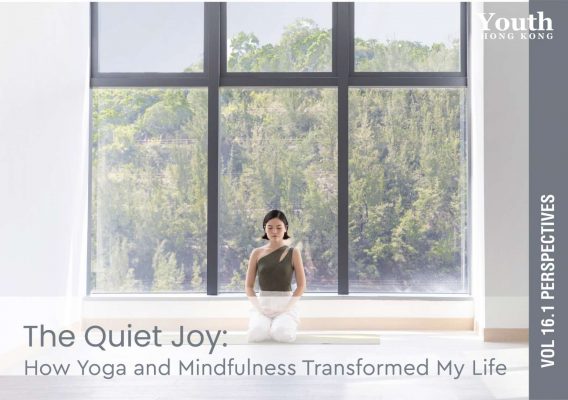//vol.16-1 Perspectives: Yoga
The Quiet Joy:
How Yoga and Mindfulness Transformed My Life
by Charlotte Lam
Yoga and mindfulness practice has taught me to acknowledge and face my feelings openly and honestly. It is a moment to slow down, be quiet, listen, and reflect on myself.
As an active practitioner of mindfulness and yoga, one might assume that I consistently maintain a stress-free and calm state. However, the reality is that the high demands of everyday life, including academic and work pressures, used to take a toll on my mental health.
I have been experiencing episodes of low mood and anxiety since high school, and it worsened since I graduated. A few years ago, there was a period when I struggled with depression. One late morning in spring, I woke up feeling fatigued as usual, wishing to linger in bed longer. Yet as I gazed out the window, I saw the vast blue sky and heard birds chirping. A sudden thought sprang up: “I need to make a change.” It was then that I discovered yoga and later mindfulness, new practices that changed my life.
Yoga, an ancient practice originating from India, has gained widespread popularity across the globe. This physical and spiritual practice includes physical poses, breathing exercises and meditation. The term “Yoga” is derived from Sanskrit, meaning “union” – a harmonious state resulting from the union of the body and mind towards the oneness of man and nature. Academic studies support the beneficial aspects of yoga practices on psychological well-being. Some people enjoy it as an exercise, and many others find it also helps to create mental clarity, relieve stress, improve attention and concentration, and elevate moods. Although the modern yoga culture emphasises posture practice, the initial idea is that through movements, one could build stability of the body and mind and start looking inward.
Of course, I enjoy all the above rewards from regular and consistent yoga practice: I especially love how the movement allows me to build strength and flexibility, and how meditation helps me increase calmness. Nonetheless, the most transformative element of yoga for my emotional health is when mindfulness is cultivated after each focusing practice – a mental state of attention in the present moment with an open attitude. That is, observing what is going on inside me. Jon Kabat-Zinn, the founder of the mindfulness-based stress-reduction programme (MBSR), defined mindfulness as “the awareness that arises from paying attention, on purpose, in the present moment and non-judgmentally.” One may then question: How does simply noticing what is happening here and now help you overcome the long-term emotional pain?
First, mindfulness helps me connect with my thoughts and emotions without judgement. Being an emotional and sensitive person, I used to find myself getting lost in a depressive mood and spiralling into negativity uncontrollably. I used to believe that I was a depressed person and that sadness would always be a part of me. I hated myself for being so emotional and unconsciously suppressed my true feelings, hoping that if I ignored my negativity, it would go away. However, as you might have guessed, it never works, and unprocessed emotions only cause more pain.
In a yoga class, in contrast, we are often asked to tap into our feelings, whether it is the “pain” from stretching, the fear from attempting some advanced pose like inversions, or the joy of maintaining a perfect balance in a tree pose. In each moment, we are encouraged to feel – the practice teaches us to acknowledge and face our feelings openly and honestly. I’ve learned that it’s okay to experience a range of positive or negative emotions, as they provide valuable information to help us make appropriate choices for our practice. This realisation has encouraged me to stop concealing my emotions in daily life and instead, accept and embrace each one.
Moreover, practising mindfulness provides me a space to observe and understand my thoughts better. By delving deeper into my mind, I realised that the root cause of my emotional triggers is my self-defeating beliefs such as: “I am a failure, and that’s why I feel unhappy and unfulfilled” or “I tend to devalue myself, and that’s why I think I will fail at everything.” As I grew more familiar with these negative thought patterns and realised that they were often unfounded, I developed more compassion and acceptance towards myself.
Finally, I’ve learned to observe my thoughts coming and going without readily identifying with detrimental thinking. Experiencing the “nature of impermanence” from yoga and mindfulness practice is what liberated me from recurring intrusive thoughts that bring heavy emotions. Every practice on the mat serves as an inner conversation in a fast-paced life – a moment to slow down, be quiet, listen, and reflect on myself.
To truly reap the full benefits of mindfulness, merely understanding the concepts is not enough, and consistent practice is essential. While my personal practice involves yoga, there are countless other activities that can help cultivate mindfulness, such as painting, playing music, cooking, or even taking a leisurely walk. The choice is limitless, but the intention of creating a state of mindful and introspective awareness is what truly matters. The joy of being able to quiet our minds and be present with ourselves is priceless. ■
Charlotte is a yoga and mindfulness teacher, photographer, and writer. With her academic background in psychological counselling, she wishes to facilitate personal growth, and help people find inner peace and a balanced life.
Tips to Live a Happier Life
- Go off the grid. Leave your smartphone at home for a day and disconnect from constant emails, alerts, and other interruptions. Spend time with friends or go for a walk in nature.
- Dance around while you do your housework. Not only will you get chores done, but dancing reduces the stress hormone, and makes you happier.
- Enjoy 15 minutes of sunshine. Sunlight synthesises Vitamin D, which experts believe is a mood elevator.
- Find ways to learn and be creative. Learning a new skill can be enjoyable and help boost your confidence. Do something creative, like drawing, taking photos or baking. This might help distract you from difficult thoughts, and help you to understand and express yourself better.




